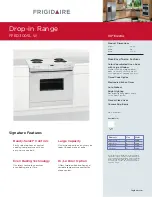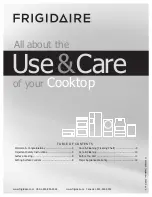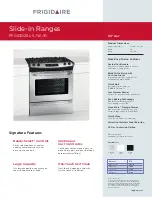
Electrical & Gas Requirements
Electrical Requirements
There is no connection necessary beyond
plugging the unit into a polarized,
grounded, 120 volt, 60 Hz, 15 amp circuit. A
minimum of 120VAC is required for proper
operation of gas ignition systems.
DO NOT
use a GFI circuit. This circuit, however,
MUST
be grounded and properly polarized. The
unit is equipped with 16-3 SPT2 power cord.
Note:
If electrical power is not supplied or is
interrupted, the open top burners will have
to be lit manually with a match.
Gas Connection
The gas supply (service) line must be the
same size or greater than the inlet line of the
appliance. All cooktops use a 1/2” (1.3 cm)
I.D. NPT (Sch40) inlet. Sealant on all pipe
joints must be resistive to LP/Propane gas.
These cooktops are designed specifically for
natural gas or liquid propane (LP) gas. It is
shipped from the factory adjusted for use
with natural or propane (LP) gas. Before
beginning installation verify that the model is
compatible with the intended gas supply.
IMPORTANT: Any conversion required
must be performed by a qualified licensed
plumber or gas service company. The
proper conversion kit must be ordered
from your authorized service agency or
dealer.
Manual shut-off valve:
• The installer-supplied valve must be
installed in the gas service line ahead of
the appliance and regulator in the gas
stream and in a position where it can be
reached quickly in the event of an
emergency.
In Massachusetts:
A “T” handle type
manual gas valve must be installed in
gas supply line to the appliance.
Pressure regulator:
• All heavy-duty, commercial-type cooking
equipment must have a pressure regulator
on the incoming service line for safe and
efficient operation, since service pressure
may fluctuate with local demand. The
regulator supplied with the cooktops must
be installed before any gas connections
are made.
• Manifold pressure should be checked with
a manometer; natural gas requires 5.0”
WCP and LP/Propane requires 10.0” WCP.
Incoming line pressure upstream for the
regulator must be 1” WCP higher than the
manifold pressure in order to check the
regulator. The regulator used on this
cooktop can withstand a maximum input
pressure of 1/2 PSI (14.0” WCP).
If
the line pressure is in excess of that
amount, a stepdown regulator will be
required.
• The appliance must be disconnected from
the gas supply piping system during any
pressure testing of that system.
15
14
66”
min
.
(167
.6 c
m)
to
72”
max
.
(182
.9 c
m)
66”
min
.
(167
.6 c
m)
to
72”
max
.
(182
.9 c
m)
24
”
(61
.0
cm
)
or
27
”
(38
.6
cm
)
30
”
(76
.2
cm
)
6”
(15
.2 c
m)
Woo
d/C
om
posit
e
Ove
rlay
Woo
d/C
om
posit
e
Ove
rlay
30”
min
.
(76.2
cm
)
to
36”
max
.
(91.4
cm
)
30”
min
.
(76.2
cm
)
to
36”
max
.
(91.4
cm
)
Wall Installation
Island Installation
Clearance Dimensions
(Wood/Composite Overlay)
The bottom of a standard hood should be
30” (76.2 cm) min. to 36” (91.4 cm) max.
above the countertop. This would typically
result in the bottom of the hood being
66” (167.6 cm) to 72” (182.9 cm) above the
floor. Refer to the rangehood installation
instructions for additional information. These
dimensions provide for safe and efficient
operation of the hood.
Summary of Contents for Designer DGSU1605BSS
Page 12: ...23 22...






























